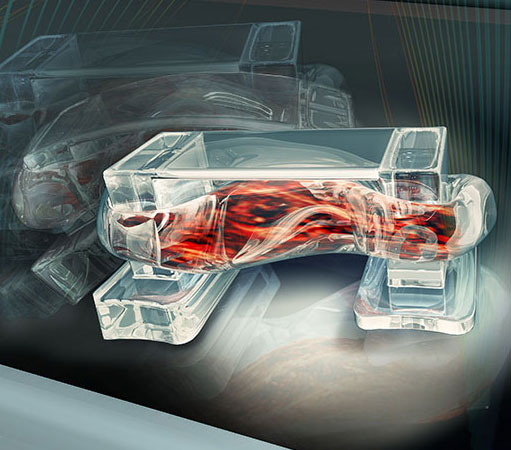| Jun 30, 2014 |
Muscle-powered bio-bots walk on command (w/video)
|
|
(Nanowerk News) A new generation of miniature biological robots is flexing its muscle.
|
|
Engineers at the University of Illinois at Urbana-Champaign demonstrated a class of walking “bio-bots” powered by muscle cells and controlled with electrical pulses, giving researchers unprecedented command over their function. The group published its work in the online early edition of Proceedings of the National Academy of Science ("Three-dimensionally printed biological machines powered by skeletal muscle").
|
 |
| Tiny walking “bio-bots” are powered by muscle cells and controlled by an electric field. (Graphic by Janet Sinn-Hanlon, Design Group@VetMed )
|
|
“Biological actuation driven by cells is a fundamental need for any kind of biological machine you want to build,” said study leader Rashid Bashir, Abel Bliss Professor and head of bioengineering at the U. of I. “We’re trying to integrate these principles of engineering with biology in a way that can be used to design and develop biological machines and systems for environmental and medical applications. Biology is tremendously powerful, and if we can somehow learn to harness its advantages for useful applications, it could bring about a lot of great things.”
|
|
Bashir’s group has been a pioneer in designing and building bio-bots, less than a centimeter in size, made of a flexible 3-D printed hydrogels and living cells. Previously, the group demonstrated bio-bots that “walk” on their own, powered by beating heart cells from rats. However, heart cells constantly contract, denying researchers control over the bot’s motion. This makes it difficult to use heart cells to engineer a bio-bot that can be turned on and off, sped up or slowed down.
|
|
The new bio-bots are powered by a strip of skeletal muscle cells that can be triggered by an electric pulse. This gives the researchers a simple way to control the bio-bots and opens the possibilities for other forward design principles, so engineers can customize bio-bots for specific applications.
|
|
“Skeletal muscles cells are very attractive because you can pace them using external signals,” Bashir said. “For example, you would use skeletal muscle when designing a device that you wanted to start functioning when it senses a chemical or when it received a certain signal. To us, it’s part of a design toolbox. We want to have different options that could be used by engineers to design these things.”
|
|
|
|
University of Illinois researchers developed tiny muscle-powered “bio-bots,” small biological machines that can be controlled with an electric current. (Video by Caroline Cvetkovic, Doug Litteken and Ritu Raman)
|
|
The design is inspired by the muscle-tendon-bone complex found in nature. There is a backbone of 3D printed hydrogel, strong enough to give the bio-bot structure but flexible enough to bend like a joint. Two posts serve to anchor a strip of muscle to the backbone, like tendons attach muscle to bone, but the posts also act as feet for the bio-bot.
|
|
A bot’s speed can be controlled by adjusting the frequency of the electric pulses. A higher frequency causes the muscle to contract faster, thus speeding up the bio-bot’s progress as seen this video.
|
|
“It's only natural that we would start from a bio-mimetic design principle, such as the native organization of the musculoskeletal system, as a jumping-off point,” said graduate student Caroline Cvetkovic, co-first author of the paper. “This work represents an important first step in the development and control of biological machines that can be stimulated, trained, or programmed to do work. It's exciting to think that this system could eventually evolve into a generation of biological machines that could aid in drug delivery, surgical robotics, 'smart' implants, or mobile environmental analyzers, among countless other applications.”
|
|
Next, the researchers will work to gain even greater control over the bio-bots’ motion, like integrating neurons so the bio-bots can be steered in different directions with light or chemical gradients. On the engineering side, they hope to design a hydrogel backbone that allows the bio-bot to move in different directions based on different signals. Thanks to 3-D printing, engineers can explore different shapes and designs quickly. Bashir and colleagues even plan to integrate a unit into undergraduate lab curriculum so that students can design different kinds of bio-bots.
|
|
“The goal of 'building with biology' is not a new one - tissue engineering researchers have been working for many years to reverse engineer native tissue and organs, and this is very promising for medical applications,” said graduate student Ritu Raman, co-first author of the paper. “But why stop there? We can go beyond this by using the dynamic abilities of cells to self-organize and respond to environmental cues to forward engineer non-natural biological machines and systems.
|
|
“The idea of doing forward engineering with these cell-based structures is very exciting,” Bashir said. “Our goal is for these devices to be used as autonomous sensors. We want it to sense a specific chemical and move towards it, then release agents to neutralize the toxin, for example. Being in control of the actuation is a big step forward toward that goal.”
|

